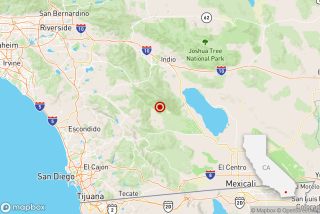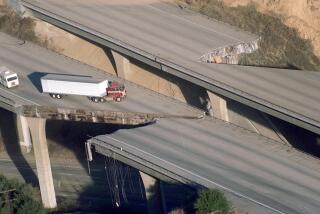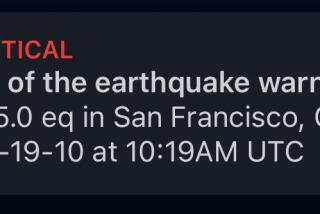California’s earthquake warning app: How much time would you get to prepare?

In a major advance for seismic safety, California Gov. Gavin Newsom announced the release of a statewide earthquake early warning app Thursday.
The MyShake app, built by UC Berkeley, will give all Californians who download it on iOS and Android phones the chance to get earthquake early warnings from any corner of the state. Authorities will also begin issuing quake early warnings through the Wireless Emergency Alerts system, offering Amber Alert-style text message alerts even for people who have not downloaded the app.
Until now, only people with the city of Los Angeles’ ShakeAlertLA app and physically present in Los Angeles County could get the alerts.
How does the system work?
The earthquake early warning system works on a simple principle: The shaking from an earthquake travels at the speed of sound through rock — slower than the speed of today’s communications systems. For example, it would take more than a minute for a magnitude 7.8 earthquake that started at the Salton Sea to shake Los Angeles, 150 miles away, traveling along the state’s longest fault, the San Andreas.
Do other places have warning systems?
Other nations, including Japan, Mexico, Taiwan and Turkey, already have operational systems. In Japan, the early warnings are a part of life — schoolchildren are trained to drop, cover and hold on when they hear alerts; TV shows are interrupted by a familiar chime and an announcer who provides details of the expected shaking; and cellphones automatically broadcast audible alerts.
How much warning would MyShake have provided if an earthquake warning system were available in 1989’s Loma Prieta quake?
Here are some estimates, according to Richard Allen, director of the Berkeley Seismology Lab:
- San Francisco’s Marina District: 20 seconds
- Candlestick Point: 15 seconds
- San Jose: A few seconds
- Santa Cruz: No warning
People too close to the epicenter won’t get a warning; the farther you are from the epicenter, the more warning time you’d probably have. San Francisco is 60 miles away from the epicenter of the 1989 earthquake, which was in the Santa Cruz Mountains.
San Francisco suffered considerable damage from that earthquake; in the Marina District, vulnerable wood apartments with flimsy first stories collapsed, killing at least three; buildings burst into flames as gas lines broke; and five people just outside a brick office building in the South of Market area were crushed to death when bricks rained down from an upper floor.
When did the MyShake alert app begin having the capability to send alerts?
Official switched the alerts on Thursday.
Where do you have to be to get the alerts if you’ve downloaded the app?
Anywhere in the state of California.
Do you have to download the app on a smartphone to get the warnings?
That’s the best move if you have a smartphone. Recent tests show people who get warnings by text message on the Amber Alert-style Wireless Emergency Alerts system might get the warning before shaking starts, but it could also be too slow, delivering the alert after shaking has already begun.
Can I have both ShakeAlertLA and MyShake on my phone?
Yes. If you’re in L.A. County, you might get two alerts.
Under what circumstances would I get an alert with the MyShake app?
The U.S. Geological Survey has hundreds of seismic sensors around California under its backbone ShakeAlert earthquake early warning system, which has been built in recent years thanks to considerable support from Congress and elected officials in Sacramento.
When an earthquake of magnitude 4.5 or greater hits, computers instantly analyze what areas of the state are expected to see an intensity of shaking described as “felt quite noticeably by persons indoors, especially on upper floors of buildings,” and causing standing cars to rock slightly, with many people thinking the vibrations are similar to a truck passing by.
That’s known as intensity level 3 on the Modified Mercalli Intensity Scale. If you’re in a zone that’s forecast to get this level of shaking, the system is designed to give you an alert on the MyShake app. (The criteria are the same as ShakeAlertLA’s.)
Is that threshold different after many people in L.A. County were mad about not getting warnings from the Ridgecrest quakes in July?
Yes. Experts had thought people wanted to be warned only in advance of damaging shaking.
They now recognize people want warnings when the shaking is scary, even if there is no damage.
Is the warning threshold different for people who do not download the MyShake app?
Yes.
Warnings sent by text message through the Wireless Emergency Alerts system will go out only to people in places where intensity level 4 shaking is expected. That’s a level of shaking described as “light,” in which many are aware of the shaking, walls make cracking sounds, and doors and windows and dishes are disturbed.
How reliable is the MyShake app?
You should expect false alarms and missed alerts. That’s part of the deal with earthquake early warning systems when they’ve operated in countries like Japan and Mexico. But the public consensus in other countries is that the system is worth the trouble because of the profound benefit you can have when the warning is correct.
What can you do with a few seconds of warning?
You can drop, cover and hold on. That will help you prevent getting injured by falling objects and protect your head and other parts of your body when the shaking is bad. In a serious shaking situation, you may be knocked to the ground, so sheltering yourself is the prudent thing to do; that’s why schoolchildren across California are taught this in elementary school.
“We are making a big leap forward in terms of focusing attention on prevention,” Newsom told reporters in Oakland at a news conference.
I see there’s a version of MyShake that’s been around since 2016. What’s that?
The first version of MyShake was designed in part as a research experiment to allow users to send shaking data from their smartphones’ motion sensors to researchers.
How long has earthquake early warning been in development in California?
Tom Heaton, a Caltech professor of engineering seismology, is credited with writing up the first serious proposal of an earthquake early warning system in the United States when he was with the USGS.
One of the first practical tests of the concept in California came after the Loma Prieta quake, which caused a section of the double-decker Interstate 880 to collapse in Oakland and ultimately killed 42 people and caused 108 injuries.
A system was devised to place sensors near the epicenter of the quake in the Santa Cruz Mountains and issue alerts by radio to rescuers working in Oakland on the damaged freeway, 60 miles away. The idea was to get the rescue workers an alert about a significant aftershock that began in the Santa Cruz Mountains to Oakland before the shaking arrived. The system worked for six months and sent 12 warnings.
How did a similar earthquake warning system in Tokyo work during the 2011 magnitude 9 earthquake?
During the 2011 magnitude 9 earthquake in Japan, viewers in Tokyo watching an NHK television channel that blared the early warning had more than a minute of notice before the strongest shaking arrived.
Will the earthquake early warning system be expanded to other West Coast states?
The USGS is working on expanding the system to Oregon and Washington. Some officials in Nevada have expressed interest in joining the system.
What are some examples of how the system could make a difference?
In the oil and gas industry, a few seconds’ warning may be enough to have crews manually shut down certain pipelines pumping fuel at high pressure — or do so automatically — and therefore avoid uncontrollable geysers of petroleum products spilling from a broken pipe and posing an explosive hazard.
Hospitals have tested visual notifications that can signal to operating room staff that an earthquake is coming so surgeons can remove their scalpels and shut off electric cauterizers to prevent fires.
Transit agencies could slow trains to reduce the chances of derailment.
Fire stations could make sure garage doors are open so firefighters can quickly get to emergencies.
Elevators could stop at the closest floor and open to let passengers out.
More to Read
Start your day right
Sign up for Essential California for news, features and recommendations from the L.A. Times and beyond in your inbox six days a week.
You may occasionally receive promotional content from the Los Angeles Times.







